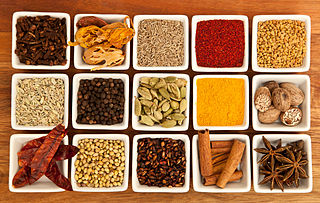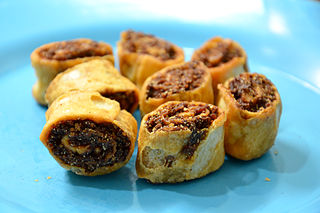
Vegetarian cuisine is based on food that meets vegetarian standards by not including meat and animal tissue products. Lacto-ovo vegetarianism includes eggs and dairy products. Lacto vegetarianism includes dairy products but not eggs, and ovo vegetarianism encompasses eggs but not dairy products. The strictest form of vegetarianism is veganism, which excludes all animal products, including dairy, honey, and some refined sugars if filtered and whitened with bone char. There are also partial vegetarians, such as pescetarians who eat fish but avoid other types of meat.

Indian cuisine consists of a variety of regional and traditional cuisines native to India. Given the diversity in soil, climate, culture, ethnic groups, and occupations, these cuisines vary substantially and use locally available spices, herbs, vegetables, and fruits.

Thali or Bhojanam is a round platter used to serve food in South Asia, Southeast Asia and the Caribbean. Thali is also used to refer to an Indian-style meal made up of a selection of various dishes which are served on a platter.

Bhelpuri is a savoury snack originating from India, and is also a type of chaat. It is made of puffed rice, vegetables and a tangy tamarind sauce, and has a crunchy texture.

Bhakri is a round flatbread (roti) often used in the cuisine of the states of Gujarat, Maharashtra, Rajasthan, and Karnataka in India. The bhakri prepared using jowar or bajra is coarser than a regular wheat chapati. Bhakri can be either soft or hard in texture, unlike khakhra in respect to hardness.

A dhaba is a roadside restaurant in the Indian subcontinent. They are on highways, generally serve local cuisine, and also serve as truck stops. They are most commonly found next to petrol stations, and most are open 24 hours a day.

Rajasthani cuisine is the cuisine of the rugged Rajasthan region in North West India. It was influenced by both the warlike lifestyles of its inhabitants and the availability of ingredients in an arid region. Food that could last for several days and could be eaten without heating was preferred. Scarcity of water and fresh green vegetables have all had their effect on the cooking. It is also known for its snacks like Bikaneri bhujia, Mirchi bada and Pyaaj kachori. Other famous dishes include Dal Baati, malaidar special lassi (lassi) and Lashun ki chutney, Mawa lassi from Jodhpur, Alwar ka mawa, Malpauas from Pushkar and rasgulla from Bikaner, "paniya"and "gheriya" from Mewar. Originating for the Marwar region of the state is the concept Marwari Bhojnalaya, or vegetarian restaurants, today found in many parts of India, which offer vegetarian food of the Marwari people. The history also has its effect on the diet as the Rajputs preferred majorly a non-vegetarian diet while the Brahmin, Jains, and others preferred a vegetarian diet. So, the state has a myriad of both types of delicacies.

Dhokla is a vegetarian culinary dish that is native to the Indian state of Gujarat and parts of adjacent states. Although a Gujarati delicacy., it is also commonly served in other parts of India. It is made with a fermented batter derived from legumes like Chickpea, Pigeon pea and Urad and rice. Dhokla can be eaten for breakfast, as a main course, as a side dish, or as a snack. Dhokla is very similar to Khaman, however Khaman is typically made from Chickpeas gram and looks yellow in color. Khaman has become widely popular outside Gujarat but is misunderstood or incorrectly known as Dhokla.

Maharashtrian or Marathicuisine is the cuisine of the Marathi people from the Indian state of Maharashtra. It has distinctive attributes, while sharing much with other Indian cuisines. Traditionally, Maharashtrians have considered their food to be more austere than others.

The fast food industry in India has evolved with the changing lifestyles of the young Indian population. The variety of gastronomic preferences across the regions, hereditary or acquired, has brought about different modules across the country.

Gujarati cuisine is the cuisine of the Indian state of Gujarat. The typical Gujarati thali consists of rotli, dal or curry, rice, and shaak. The thali will also include preparations made from pulses or whole beans such as moong, black eyed beans etc., a snack item (farsaan) like dhokla, pathra, samosa, fafda, etc. and a sweet (mishthaan) like mohanthal, jalebi, doodh pak etc. Gujarati cuisine varies widely in flavour and heat, depending on a family's tastes as well as the region of Gujarat to which they belong. North Gujarat, Kathiawad, Kachchh, Central Gujarat and South Gujarat are the five major regions of Gujarat that contribute their unique touch to Gujarati cuisine. Many Gujarati dishes are distinctively sweet, salty, and spicy simultaneously.

According to the 2011 national census, the population of Ahmedabad was declared to be 7,214,225. This figure was only limited to the municipality region. The total population of the Ahmedabad Urban Agglomeration came to 7.2 million people. There were 886 females to every 1000 males in 2001. Now there are 904 women to 1000 men in 2011. Ahmedabad had a literacy rate of 79.89% in 2001 which rose to 89.62 percent in 2011. Out of this, male and female literacy are 93.96 and 84.81 percent as of 2011 census. According to the census for the ninth plan, there are 30737 rural families living in Ahmedabad. Out of those, 5.41% live below the poverty line. There are 439,843 people who live in slums in the city. The majority of residents of Ahmedabad are native Gujaratis and speak Gujarati. There is also a sizable population of Punjabis, Marathis, Tamils, Sindhis, Malayalis and Marwaris who bring in their native language and culture to the city. The government institutions and military base near the city also bring peoples from across India. The city's population has increased in a major way following increasing economic expansion and modernization.

Konkani cuisine is the cuisine of the Saraswat Brahmins from the Konkan region on the western coast of India. Konkani cuisine differs within the Saraswat Brahmin subsects and within the Konkan-Canara region. Konkani cuisine originally hails from the Konkan region including Uttara Kannada, Udupi district, Dakshina Kannada, Damaon, and Goa, India. Konkani cuisine is popular served in many restaurants throughout the western coast of India, and especially in the cities of Bombay and Bangalore. Each variation has its unique flavour and makes uses of different vegetables and fruits available in the region. Konkani cuisine is usually pesco-vegetarian, except acharyas and purohits who follow a strictly saatvik vegetarian diet. According the Konkani folklore, fish, meats are regarded as sea vegetables. Historically, they have refrained from eating any terrestrial animals in general.

Maharashtra is the third largest state of India in terms of land area and second largest in terms of population in India.It has a long history of Marathi saints of Varakari religious movement, such as Dnyaneshwar, Namdev, Chokhamela, Eknath and Tukaram which forms the one of bases of the culture of Maharashtra or Marathi culture. Maharashtra had huge influence over India under the 17th-century king Chatrapati Shivaji Maharaj of the Maratha Empire and his concept of Hindavi Swarajya which translates to self-rule of people.

Farsan or Pharsāṇ refers to salty snacks originating from the Indian subcontinent. Farsans are a very important part of Gujarati cuisine, Marathi cuisine and Sindhi cuisine, wherein a wide variety of them are prepared on special occasions and to entertain guests, and are also enjoyed with tea. Farsan is also found throughout the rest of India, particularly Maharashtra due to the influx of Gujarati and Rajasthani traders and migration of Sindhis in Mumbai.
Marwari Bhojnalaya is a popular name among Marwari-style purely vegetarian restaurants in many cities in India. They are all independently owned. The term "marwari" implies that it is intended for Marwari merchants, who are strictly vegetarian and prefer relatively simple and inexpensive food. They are however popular among all vegetarians. The term "bhojanalaya" practically always implies simple and inexpensive vegetarian cuisine. Restaurants named "Jain Bhojanalaya" or "Vaishanva Dhaba" are also vegetarian. Note that restaurants are often called "hotel" in India. Some of them used to offer traditional seating on wooden patiyas on the floor, but the custom is no longer popular and tables and chairs are now more common.

Tarla Dalal was an Indian food writer, chef, cookbook author and host of cooking shows. Her first cook book, The Pleasures of Vegetarian Cooking, was published in 1974. Since then, she wrote over 100 books and sold more than 10 million copies. She also ran the largest Indian food web site, and published a bi-monthly magazine, Cooking & More. Her cooking shows included The Tarla Dalal Show and Cook It Up With Tarla Dalal. Her recipes were published in about 25 magazines and tried in an estimated 120 million Indian homes.

Sev is a popular Indian snack food consisting of small pieces of crunchy noodles made from chickpea flour paste, which are seasoned with turmeric, cayenne, and ajwain before being deep-fried in oil. These noodles vary in thickness. Ready-to-eat varieties of sev, including flavoured sev, are available in Indian stores.

Bakarwadi in Marathi & Bhakharwadi in Gujarati is a Gujarati & Maharashtrian traditional crispy, deep-fried, disc-shaped, sweet and spicy snack popular in western states of Gujarat and Maharashtra in India. It was already popular before 1960 when these were not Gujarat nor Maharashtra state; they were both Bombay State and both cultures added their own flavors in each other's recipes.

Indigo was a restaurant founded by the Indian chef Rahul Akerkar in 1999 in Mumbai, India, which was in a restored colonial bungalow behind the Taj Mahal Palace Hotel. The restaurant gained iconic status as it was one of the first standalone fine-dining restaurants in the country to serve quality European cuisine, while functioning independently outside the luxury hotels industry. It is credited with influencing the Indian restaurant industry in the country's post-liberalisation era. Food critic Vir Sanghvi called the restaurant "one of the most important establishments in Indian restaurant history". It was included in the top 60 restaurants in the world by Condé Nast Traveler.
















